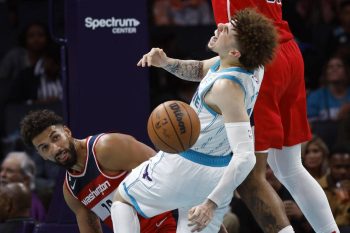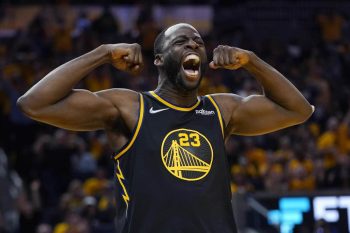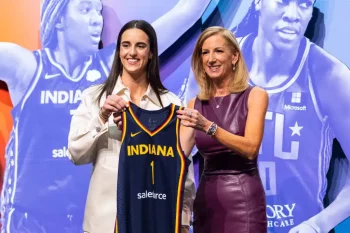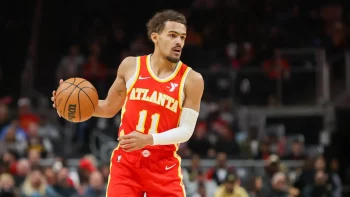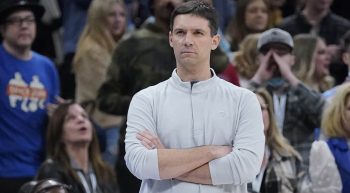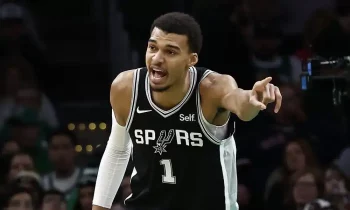NBA
NBA Daily: To Tank Or Not To Tank, That’s The Question In Brooklyn

The Brooklyn Nets, fresh off three straight seasons of disappointing results, finally looked halfway competent to start the 2018-19 campaign. Fueled by the impending breakout of Caris LeVert, the Nets began the year a very manageable 6-7 — a record that had them in the mix for a postseason berth within a muddied Eastern Conference. With big-time homegrown assets like Spencer Dinwiddie and Joe Harris making strides and youngsters like D’Angelo Russell and Jarrett Allen on the up-and-up, it was officially time to be optimistic, if not downright positive, in Brooklyn once again.
Then disaster struck all at once.
Despite the minor miracle surrounding the brutal, gut-wrenching injury that LeVert suffered on Nov. 12 in Minnesota, his absence has buried the Nets from the inside out. Since then, the Nets have gone 3-10 and now sit only three games back from the ever-so-familiar territory of the conference basement. During this low streak, Brooklyn has blown multiple double-digit leads, gave the win away against Memphis (twice) and suffered a 14-point loss to the dysfunctional Washington Wizards. From playoff contenders to the bottom of the ladder at the snap of a finger, it’s gone from bad to worse very quickly for the Nets.
Well, unless you’ve got your eye on the 2019 NBA Draft, that is.
This is, of course, the first season that the Nets have held their own draft pick since 2013. And, perhaps rightfully so, there are compelling arguments to now release the safety brakes and tank out, especially with LeVert no longer leading the way. Zion Williamson, R.J. Barrett and Cam Reddish represent the crown jewel trio of NBA-ready prospects and adding any of them — let alone the hulking Bol Bol or high-scoring Romeo Langford — would jumpstart the Nets’ rebuild in a way not yet seen. Still, the Nets have said from the start of training camp that they’d try to be competitive because their attempt to develop a winning culture needs, well, wins.
Tired of losing — 69-177 over the last three seasons will do that to a franchise — the Nets have constantly put themselves in a position to win, at least for the first 36 minutes or so. But with so many crucial, organization-altering decisions on the very near horizon, Brooklyn will need to reevaluate their direction if the losses continue to pile up. At what point does incubating culture come at the expense of missing out on an elite prospect? On the other hand, their error-prone defeatism would certainly put a toll on a growing roster, head coach and front office if it continued until April as well.
Aside from outright winning — LeVert’s injury was cruel timing in more ways than one — there appears to be no unanimously great path forward from here.
For example, there’s the internal struggle over Spencer Dinwiddie and D’Angelo Russell. As two of the Nets’ best players, a desire to retain them both is understandable — but unless one is willing to come off the bench for the foreseeable future, it may not be the road the franchise wants to head down. Dinwiddie is eligible for his extension worth $47.5 million on Dec. 8 and the Nets’ biggest success story in Brooklyn remains candid about his desire to either stay or test the free agent market come June. The flipside of this two-headed coin is Russell, a younger, higher-ceiling guard that has struggled to find consistency every night thus far. Russell is the only roster member capable of the 38-point, 8-rebound, 8-assist effort he dropped last month against the Philadelphia 76ers, but also he’s spent many late-game scenarios glued to the bench as well.
Russell, as luck would have it, is a restricted free agent come July and he’ll likely have a long list of suitors himself. If the Nets commit to Dinwiddie, they could end up letting Russell walk for nothing. If the Nets take a wait-and-see approach to Russell, they could obviously lose Dinwiddie and leave that situation empty-handed instead.
(For more on this intriguing dilemma, check out Drew Maresca’s most recent piece here.)
Utilizing them both will have a negative impact on the Nets’ eventual lottery position — unless, naturally, the organization truly believes they can tread water until LeVert’s undetermined return. But the Nets will need to decide if hanging around eighth place is really worth missing out on a blue-chip prospect. Even if Brooklyn won’t commit to one or both (or neither) of their point guards just yet — Dinwiddie is extension-eligible until Jun. 30 — there’s another tweak that could help determine their best-foraged way to the future: The often-maligned youth movement.
There’s a clamor for another youth movement in Brooklyn that grows louder with each defeat, this time for Dzanan Musa, Rodions Kurucs, Theo Pinson and Alan Williams. Frankly, the foursome has been tearing up the G League for the Long Island Nets and the thought-process here is rather simple. Play the prospects and rookies and if they energize an at-times lethargic Nets squad — see Kurucs versus the Knicks — then great. If it doesn’t and the Nets keep falling down the conference ladder, then at least their future assets will have gained valuable experience at the NBA level.
Musa, the No. 29 overall pick in the 2018 NBA Draft, has appeared in just seven games so far, most often as the ceremonial white flag in a loss. On Long Island, Musa has averaged 20 points, 6.4 rebounds, 2.8 assists and 1.3 steals per game — but as he’s stuck behind a veteran-laden backcourt rotation, there may not be a true opportunity here without a trade. For Kurucs, his previous exclusion has been harder to quantify. Kurucs was forced into the rotation after preseason injuries to Rondae Hollis-Jefferson and DeMarre Carroll and the 20-year-old Latvian not only held his own, he thrived.
He’s tallied 7.3 points and 3.3 rebounds over 12.3 minutes per game, an athletic forward finding his place through aggressive open court action and a willingness to get dirty. An injury of his own knocked Kurucs back out of the rotation briefly — wherein that time, Hollis-Jefferson and Carroll both returned — but head coach Kenny Atkinson recently admitted that they may need to find more time for him moving forward.
The pair of two-way signees, Wiliams and Pinson, are considerably less urgent since the Nets can shuttle them between teams for up to 45 days before a decision has to be made. In any case, it’s not hard to imagine that both could help the Nets right now if that’s what the team is still aiming for in 2018-19. For argument’s sake, Brooklyn’s front office could be auditioning the likes of Jared Dudley, Kenneth Faried and the aforementioned Carroll — all of whom are expiring contracts — ahead of the trade deadline. Last season, the Nets’ extracted a second-round pick out the Milwaukee Bucks for Tyler Zeller, so that route is sensical, especially for general manager Sean Marks.
However, Faried has barely seen the floor at all, notching only 5.6 minutes over just eight contests so far. As of Friday, the Nets ranked 25th in rebounds per game at 32.7 and Faried, an eight-year veteran, has gobbled up a career average of 8.1 of them along the way but this seemingly perfect union hasn’t come together. Faried would conceivably help the Nets with their rebounding issues and put him front and center for a potential move elsewhere, so its become an overall confusing footnote indeed. Williams, a former NBA center himself, has pulled down 13.9 rebounds in just 25.2 minutes per game for Long Island — he, in all likelihood, is too good for the G League.
Elsewhere, Carroll underwent a career resurgence in Brooklyn in 2017-18 and he’d be worth a valuable return on the trade market if he’s available — but if the Nets still want to reach the postseason, the gritty veteran would almost definitely remain in their plans. Lastly, there’s Hollis-Jefferson, who, like Russell, will venture into restricted free agency this summer too. While the stretchy forward has been solidly part of the Nets’ rebuild, he could be an eventual casualty depending on how the Dinwiddie-Russell conundrum unfolds. Basically, there are difficult puzzles to solve here without any discernable, clear-cut answers.
But when the overarching goal is to compete despite the loss of your best player, the water gets muddied quickly. It’s hard to find time for both the veteran on an expiring contract and the scrappy rookie when those late-game wins turn into shocking losses time and time again.
Stuck between two frames of mind, the franchise has been tossed into a difficult position — to tank or tread water, that is the debate. LeVert’s injury turned a promising season into turmoil, but sooner rather than later, the Nets will need to take stock and determine how to most effectively proceed. Whether that’s the calculating the value of their two electric guards or the puzzling use of those back-of-the-rotation assets, it’ll be a busy winter and spring for the Nets’ front office, full of challenging questions that absolutely require the right answers.
Until then, even if the agonizing defeats continue to rise, the Nets must simply decide what kind of team they want to be.
